Price reductions at Crocus
by Sarah - October 22nd, 2009.Filed under: Crocus, Price Reductions.
Crocus has discounted the price of loads of products today
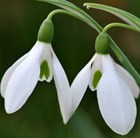
common snowdrop was £1.99 now £0.99
Position:sun or partial shade Soil: humus-rich, moist but well drained soilRate of growth: average Flowering period: January and February Flower colour: white Other features: all parts of the plant may cause a mild stomach upset if ingested; contact with the bulbs may cause skin irritationHardiness: fully hardyBulb Size: 4/5It’s hard not to love these wonderful bulbs for adding colour to the garden when little else is awake. The nodding white flowers have a small green marking on the inside of each tepal, are honey scented, and appear in late winter. They look particularly good planted in large drifts in grass where they will naturalise quite happily. Alternatively plant them up in clumps in the front of mixed borders, or into pots so they can be admired close up.Garden care: Plant bulbs 5cm deep in dense clusters to form naturalistic drifts. Where bulbs are planted in grass do not cut the grass until after the leaves have died right back. Divide large colonies after flowering while the leaves are still green for use in other moist, well-drained areas.
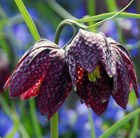
snake’s head fritillary was £2.49 now £1.24
Position: full sun or partial shadeSoil: humus-rich, moisture-retentive soilRate of growth: averageFlowering period: April and MayFlower colour: purple and whiteOther features: narrow, grey-green leavesHardiness: fully hardyPretty, pendent, white and pinkish-purple bells with distinctive checkerboard markings on slender stems in April and May. These delightful snake’s head fritillaries are perfect for naturalising in a moist woodland edge or wildflower garden. It’s essential to select a site where the soil remains moist in summer.Garden care: Plant 12cm (5in) deep from September to November in fertile, well-drained soil, taking care not to damage the fragile bulbs.
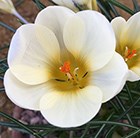
crocus was £2.99 now £1.49
Position: full sunSoil: gritty, poor to moderately fertile, well-drained soilRate of growth: average to fast-growing Flowering period: February and March Flower colour: rich-cream with a yellow throatOther features: slender, strap-shaped, mid-green leavesHardiness: fully hardyBulb Size: 5/7Rich-cream goblets with brown flushes and deep golden-yellow throats, emerge in February and March amid slender, strap-shaped, mid green leaves. These spring-flowering crocuses are perfect for naturalising in sunny, well-drained areas of the lawn. Relatively vigorous, they soon form large colonies, which can be divided in early autumn for use in other parts of the garden.Garden care: Plant bulbs in tight clusters to form naturalistic drifts 10cm deep where they can be left undisturbed for several years. Keep a look out for mice or squirrel damage This can sometimes be avoided by laying a piece of chicken wire over the bulbs before you cover them with soil. If you are growing these in grass, avoid mowing it until the leaves have completely died back.
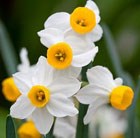
species daffodil was £2.99 now £1.49
Position: full sun or partial shadeSoil: well-drained soil Rate of growth: fast-growing Flowering period: March and April Flower colour: white petals with a yellow cupOther features: excellent cut-flowersHardiness: fully hardyBulb Size: 12/14Plant this at the front of your border, in a pot or in your windowboxes where you can enjoy the small, scented flowers up close. This variety produces several flowers on each stem so they are really colourful. The flowers have white petals with a small yellow cup and they look best in bold clumps.Garden care: Wearing gloves plant bulbs 10-15cm deep and 10cm apart in autumn. After flowering feed with a balanced fertiliser, dead-head the flowers, but do not be tempted to cut back or tidy the foliage after flowering as this will interfere with the bulbs ability to store energy for the following year’s flowers.
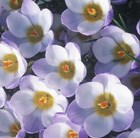
crocus was £2.99 now £1.49
Position: full sunSoil: gritty, poor to moderately fertile, well-drained soilRate of growth: averageFlowering period: February and March Flower colour:pale lilac-blue Other features: slender, strap-shaped, grey-green leavesHardiness: fully hardyBulb Size: 5/7Yellow-throated, white flowers with soft, silvery, lilac-blue outer petals in February and March. The flowers are framed by slender, strap-shaped, grey-green leaves. These spring-flowering bulbs are versatile and easy-to-grow. They are suitable for naturalising in grass or planting in sunny areas of a rock garden or shrub border. They need well-drained soils and prefer dry summers.Garden care: Plant bulbs in tight clusters to form naturalistic drifts 10cm deep where they can be left undisturbed for several years. Keep a look out for mice or squirrel damage. This can sometimes be avoided by laying a piece of chicken wire over the bulbs before you cover them with soil. If you are growing these in grass, avoid mowing it until the leaves have completely died back.
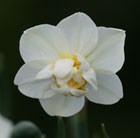
double daffodil was £2.99 now £1.49
Position: full sun or partial shadeSoil: well-drained soil Rate of growth: fast-growing Flowering period: March and April Flower colour: creamy-whiteOther features: excellent cut-flowersHardiness: fully hardyBulb Size: 12/14A creamy-white, late flowering daffodil which usually appears in clusters on top of the upright stems. The strongly scented flowers do not resemble your traditional yellow trumpets, but are fully double so look ruffled and are said to resemble carnations. They look great planted in small drifts in a mixed or shrub border, or can be potted up as part of a seasonal bedding display.Garden care: Wearing gloves plant bulbs 10-15cm deep and 10cm apart in autumn. After flowering feed with a balanced fertiliser, dead-head the flowers, but do not be tempted to cut back or tidy the foliage after flowering as this will interfere with the bulbs ability to store energy for the following years flowers.
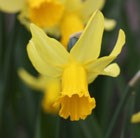
cyclamineus daffodil was £2.99 now £1.49
Position: full sun or partial shadeSoil: well-drained soil Rate of growth: fast-growing Flowering period: March and April Flower colour: yellowOther features: excellent cut-flowersHardiness: fully hardyBulb Size: 14/16An old variety that has stood the test of time and is still deservedly popular. Brilliant for adding early colour (although February may be a little bit of a push unless we have a very mild winter!), these small, cheery flowers should be planted in big clumps for maximum impact. They also do really well in pots and windowboxes.Garden care: Wearing gloves plant bulbs 10-15cm deep and 10cm apart in autumn. After flowering feed with a balanced fertiliser, dead-head the flowers, but do not be tempted to cut back or tidy the foliage after flowering as this will interfere with the bulbs ability to store energy for the following year’s flowers.
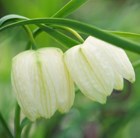
fritillary was £2.99 now £1.49
Position: full sunSoil: fertile, well-drained soilRate of growth: averageFlowering period: April and MayFlower colour: creamy green to whiteOther features: grey-green leavesHardiness: fully hardyBulb Size: A rarely seen fritillary that produces open clusters of two to six, creamy, bell or cup-shaped flowers that often have pale green mottling or veining. Each of these nodding flowers will grow to around 3.5cm long, and they look great against the narrow grey-green foliage. Plant it in a prominent spot in the border, or try it in a deep pot filled with a good compost – John Innes No. 2 is ideal.Garden care: Plant 12cm (5in) deep from September to November in fertile, well-drained soil, and keep an eye out for slug and snail damage when the new foliage is emerging in spring. Keep reasonably dry while dormant.
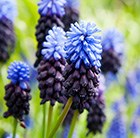
grape hyacinth was £2.99 now £1.49
Position: full sun or light shadeSoil: moderately fertile, well-drained soil (for container-grown bulbs use two parts John Innes No2 compost to one part sharp grit)Rate of growth: averageFlowering period: MarchFlower colour: dark blue topped with paler blue flowersOther features: can be brought indoors for short periods when in flowerHardiness: frost hardyBulb Size: 7+This is such a great little plant that in summer 2005 it was voted as the International Flower Bulb Centre’s official bulb of the year. The bottom two thirds of the flowers are coloured a very dark blue and appear near black in certain lights. Each spike is topped by a tuft of striking bright blue flowers giving it a two-tone effect. Its leaves are broader and flatter than most other grape hyacinths and they tend to wrap themselves around the stem of each flower rather than just jut up. It is a small plant that packs a big punch when planted in big, naturalistic drifts. Mix it with other spring flowers in an orchard or meadow – try planting it with the hoop petticoat daffodil for great colour contrast. Alternatively cram loads into a pot and place it on a sunny patio.Garden care: Plant 10cm (4in) deep in naturalistic groups in autumn. During summer when the bulbs are dormant lift and divide groups that are becoming congested.
species daffodil was £2.99 now £1.49
dog’s tooth violet was £3.49 now £1.74
Dutch garlic was £3.49 now £1.74
tazetta daffodil was £3.49 now £1.74
poeticus daffodil was £3.49 now £1.74
jonquilla daffodil was £3.49 now £1.74
triandrus daffodil was £3.49 now £1.74
early crocus was £3.99 now £1.99
bluebell was £3.99 now £1.99
Jonquilla Daffodil was £3.99 now £1.99






